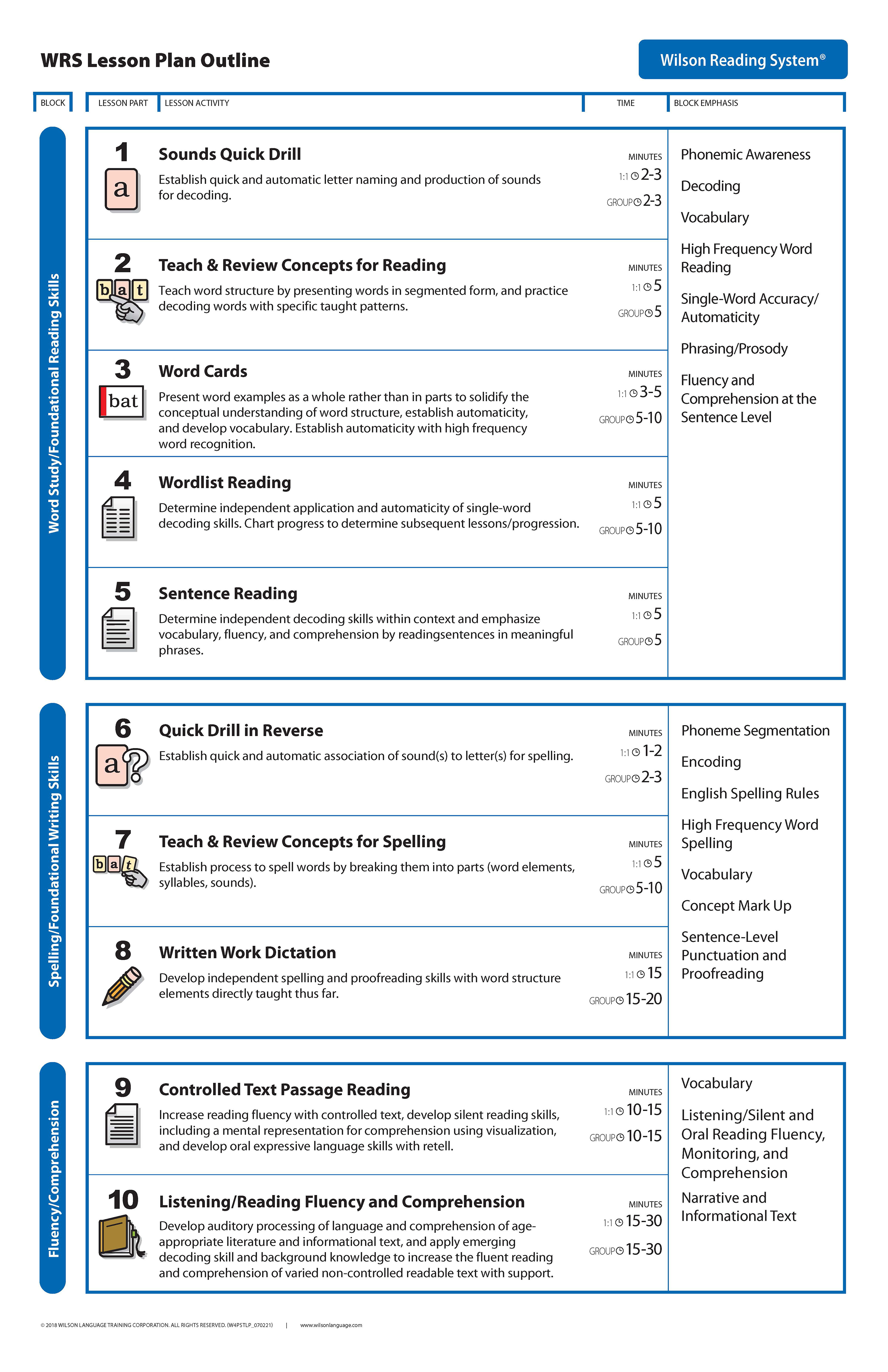

 Reading comprehension with narrative and expository text of increasing levels of difficulty. Listening comprehension with age-appropriate narrative and informational text. Sentence-level text reading with ease, expression, and understanding. Vocabulary, word understanding, and word-learning skills.
Reading comprehension with narrative and expository text of increasing levels of difficulty. Listening comprehension with age-appropriate narrative and informational text. Sentence-level text reading with ease, expression, and understanding. Vocabulary, word understanding, and word-learning skills.  Word recognition and spelling of high frequency words, including irregular words. Word structure, in depth, for automatic decoding and spelling. Key components directly addressed in WRS are: Throughout the program, teachers follow a ten-part lesson plan that provides for extensive teacher-student interaction and multisensory learning methods. From the beginning steps of the program, instruction also addresses high frequency words, fluency, vocabulary, oral expressive language development and comprehension with progressively more challenging text. It provides a complete curriculum for explicitly and systematically teaching decoding and encoding (spelling). stand for in Comprehension S.O.S."The Wilson Reading System® (WRS) directly teaches the structure of the English language using an organized and sequential system in 12 Steps, not corresponded to school grade levels. student reader Lesson Part 6: Teachers should use the _ page from the Dictation Book to plan this par What Says? Lesson Part 7: What should the student always do after the teacher dictates a word in this part of repeat the word Lesson Part 7: Where should the teacher locate words to use when planning this part of the lesson? dictation book Lesson Part 7: When students begin to work with multisyllabic words, it is important for them to _ name and spell one syllable at a time Lesson Parts 9 & 10: What does the S.O.S. The step-specific Student Reader Lesson Part 5: The sentences for the student to read in this part of the lesson are found in the _. helps the student stay connected to the text and helps to develop fluency and expression Lesson Part 5: The teacher should question about vocabulary and meaning to _ check for comprehension Lesson Part 5: To plan this part of the lesson, the teacher should use the _. independent application of automaticity of single-word reading Lesson Part 5: Tracking the sentence with a pencil_. the entire list of words Lesson Part 4: The teacher should record the student errors on _? the wordlist chart Lesson Part 4: The objective of this part of the lesson is to determine_.
Word recognition and spelling of high frequency words, including irregular words. Word structure, in depth, for automatic decoding and spelling. Key components directly addressed in WRS are: Throughout the program, teachers follow a ten-part lesson plan that provides for extensive teacher-student interaction and multisensory learning methods. From the beginning steps of the program, instruction also addresses high frequency words, fluency, vocabulary, oral expressive language development and comprehension with progressively more challenging text. It provides a complete curriculum for explicitly and systematically teaching decoding and encoding (spelling). stand for in Comprehension S.O.S."The Wilson Reading System® (WRS) directly teaches the structure of the English language using an organized and sequential system in 12 Steps, not corresponded to school grade levels. student reader Lesson Part 6: Teachers should use the _ page from the Dictation Book to plan this par What Says? Lesson Part 7: What should the student always do after the teacher dictates a word in this part of repeat the word Lesson Part 7: Where should the teacher locate words to use when planning this part of the lesson? dictation book Lesson Part 7: When students begin to work with multisyllabic words, it is important for them to _ name and spell one syllable at a time Lesson Parts 9 & 10: What does the S.O.S. The step-specific Student Reader Lesson Part 5: The sentences for the student to read in this part of the lesson are found in the _. helps the student stay connected to the text and helps to develop fluency and expression Lesson Part 5: The teacher should question about vocabulary and meaning to _ check for comprehension Lesson Part 5: To plan this part of the lesson, the teacher should use the _. independent application of automaticity of single-word reading Lesson Part 5: Tracking the sentence with a pencil_. the entire list of words Lesson Part 4: The teacher should record the student errors on _? the wordlist chart Lesson Part 4: The objective of this part of the lesson is to determine_. 
Lesson Part 3: The stack of word cards used should include: previous and current substep words Lesson Part 3: In addition to practicing phonetically regular words for reading, the student should kept in a separate packet Lesson Part 4: When practicing for Wordlist Reading / Charting: have the student read just 5 to six words Lesson Part 4: When charting, the student should read _.








 0 kommentar(er)
0 kommentar(er)
